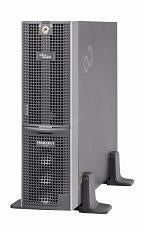

 |
Fujitsu is pretty emphatic when talking about its 1-way TX120 server. The company claims it has built the world’s smallest and quietest server, with the highest standard in energy efficiency. It achieves this via smaller hard drives, heat pipes and other components. The TX120’s power consumption is a scant 175 watts using a dual-core Xeon processor 3070 (2.66GHz)/3040 (1.86GHz).
As Fujitsu strives to reduce its carbon footprint, it looks to the SMB crowd and delivers the world’s smallest and quietest server — with a few design twists.
“This server would be fine for a small office of five to 20 users depending on the application,” said Richard McCormack, senior vice president of marketing at Fujitsu Computer Systems (Sunnyvale, Calif.). “The Primergy TX120 server represents a significant step forward in accommodating the real-world IT needs of small offices.”
Fujitsu is endeavoring to reduce the carbon footprint of all of its products. It is achieving this on several fronts. In the cooling arena, it has developed a heat pipe cooling method and what it calls straight-line cooling to keep servers cool without the attendant noise of heavy duty fans.
This is a redesign of the previous heat pipe air cooling system used in Fujitsu servers. To reduce the size of the unit, engineers realigned the components. CPU, chipsets and other heat-emitting components are positioned along a linear heat pipe. Two temperature controlled fans are also used. They sit at either side of the pipe in a push-pull arrangement. That produces a noise output of 32dB when operating and 28dB when idle — a level well below the background noise in a typical office.
|
Recent Server Snapshots » Server Snapshots: City Goes Virtual with IBM » Server Snapshots: Spotlight on IBM » Server Snapshots: IBM System Storage DS8000 Turbo Read More Server Snapshots |
“These servers combine large diameter fans, straight through airflow design and advanced modeling techniques to optimize server cooling,” said McCormack. “This combination — which we call Cool-Safe — enables air to flow easily through the server,
which saves energy because fans do not have to work as hard.”
Why would the fans in a super-compact server be larger and not smaller? Large diameter fans, it turns out, spin more slowly and produce less noise and vibration. Fujitsu modeled the airflow to prevent the formation of pockets of intense heat inside the server.
With these design specs, it’s no surprise the TX120 makes use of 2.5-inch SAS drives. When two disks are used, they can be mirrored using RAID 1. Despite its size, the server has three PCI slots. It supports up to 8GB. Further, it can be bought with remote management software to take care of functions like power on/off and restart.
“The end result is a tiny package that takes up about a quarter of the room of a traditional tower server,” said McCormack.
Processor choice is the dual-core Xeon 3070 (which runs at 2.66GHz), the dual-core Xeon 3040 (1.86GHz) or an Intel Celeron 440 (2.0GHz), for those willing to trade some performance for a lower price.
At the bottom of the pricing ladder is the Celeron system for $1,058. It has a 2 GHz processor, 512 MB of RAM, a DVD-RW and a 73GB SAS drive running at 10k rpm. For $3,666.90, you get a Xeon 3070 processor running at 2.66GHz, 2GB of memory, a DVD-RW and a 146GB SAS drive.
Target — Public
This server isn’t aimed at the data center. Fujitsu has identified it specifically as a machine to be stationed close to end users. The TX120, in fact, is an example of how the competition for the SMB server market segment is heating up.
“All of the major vendors are creating SMB friendly products in both blade and tower form factors,” said John Enck, an analyst at Gartner (Stamford, Conn.). “As represented by the thermal and acoustical characteristics of the TX120, these products are designed to fit well into non-data-center spaces.”
McCormack cites environments, such as retail, schools, hospitals, libraries and offices, where a server is needed but not a traditional server, which isn’t always quiet. These locations generally perform tasks such as file sharing, accessing of user records, e-mail serving and invoicing.
“Retail has limited space, schools and hospitals should be quiet, offices should be cool and eco-friendly, and small businesses need all that with price performance as well,” said McCormack. “They want unobtrusive equipment that doesn’t change the ambience of the work environment.”
Fujitsu hopes the Primergy TX120’s compact size and whisper-quiet operation will enable it to meet those needs. In addition to SMBs, larger companies with remote offices or those seeking a departmental server may also find much to like about the server.
Typical uses include a file/print server for up to 50 users, a mail server for 200 users (POP3/IMAP), and an application server for 20 users. The TX120 can also be used for basic server tasks, such as domain login and DHCP.
“Because of this server’s quiet operation and thriftiness with power, it also is a good option for a single-room office that needs a more reliable server option,” said McCormack. “A typical server creates too much noise to be kept close to where people are talking and working.”
He believes the TX120 serves as a good machine up to which small businesses can graduate. When the performance of their small applications begins to bog down on desktop systems due to hard drive or memory limitations, for example, the TX120 could easily carry the load.
“The TX120 offers high availability features such as hot-plug hard drives, RAID 1 mirroring, ECC memory, plus pre-failure alerts on fans and hard drives,” said McCormack. “All of these features warn/protect you from potential problems and keep your business running smoothly.”
In addition, its Remote Management chip — the iRMC (integrated Remote Management
Controller) — gives small IT teams at remote sites and small businesses a way to remotely manage their TX120s. IT staff members can remotely connect to the server and have access to full remote control to change settings or troubleshoot.
“The primary design goal of the Primergy TX120 was to combine the performance, reliability, and powerful remote management features in a package with industry leading environmentals (power, heat, noise and size),” said McCormack.
| Name | Primergy TX120 |  |
| Vendor | Fujitsu | |
| Platform | x86 | |
| Dimensions | 99mm (W) x 399mm (D) x 340mm (H) | |
| Processor Details | Dual-Core Intel Xeon 3070 (2.66GHz), 3040(1.86GHz) or Celeron 440 2.0GHz | |
| Hard Drives | 2 hard drives, for up to 293.6 GB | |
| Operating Systems | Windows and Red Hat Linux | |
| Configuration Options | Celeron 440 (2.0GHz) with 512MB RAM and one 73 GB SAS drive, $1,080.66 Xeon UP 3070 (2.66GHz) with 2GB RAM and 146 GB 146 GB SAS drive, $3,666.90 |
|
| Availability | Generally available | |
| Warranty | 3 years | |
Property of TechnologyAdvice. © 2025 TechnologyAdvice. All Rights Reserved
Advertiser Disclosure: Some of the products that appear on this site are from companies from which TechnologyAdvice receives compensation. This compensation may impact how and where products appear on this site including, for example, the order in which they appear. TechnologyAdvice does not include all companies or all types of products available in the marketplace.